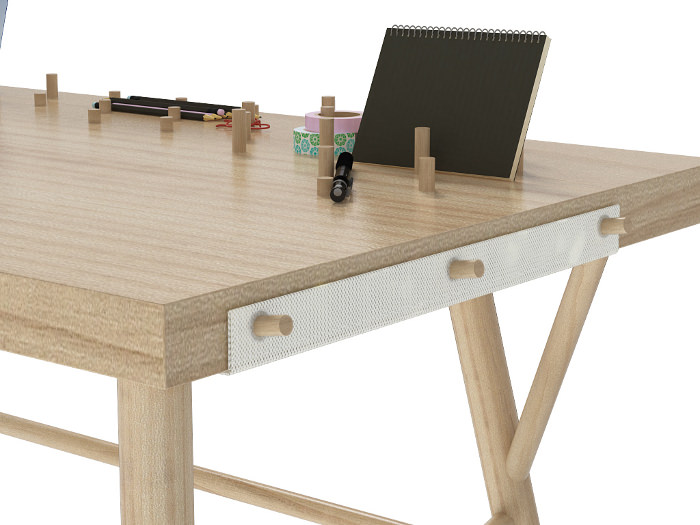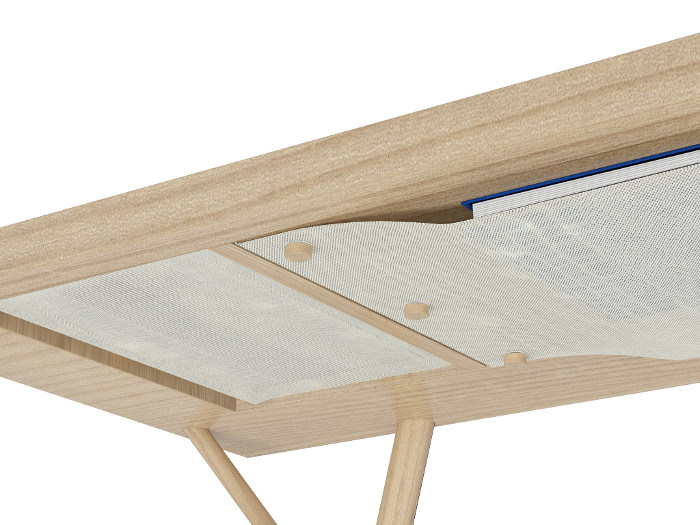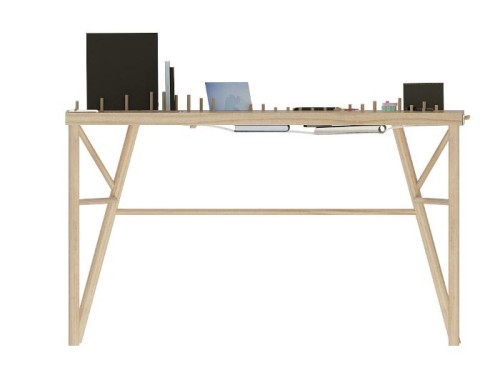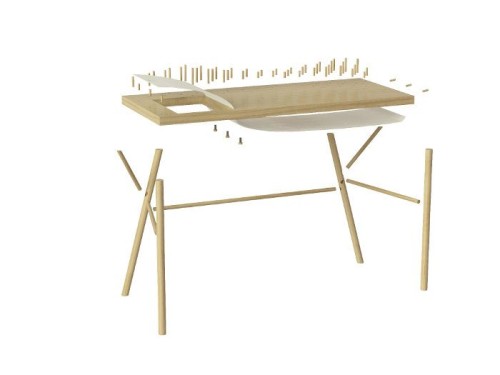Wooden Structure for the Haesley Nine Bridges Golf Club House in Yeoju, Gyenggi, South Korea.
Architects: Kyeong Sik Yoon, Shigeru Ban
The structure was inspired by the "Bamboo Wife." The structure allow the breeze to flow through it in order to keep the the place cool. It also allows the light to filter through. The structure is made out of natural, local, sustainable materials. The architects make use of the wooden elements by separating them into different modules.
Saturday, February 22, 2014
Ana Mernik Looking Out Week 7
David Jameson Architects designed a steel and wood teahouse that also serves as meditation and performance space. The structure imitates a Japanese lantern, a symbol for mindfulness and meditative detachment from thoughts or time. The surrounding bamboo and stone pathway give the feeling of an in-between space from the family house to the pavilion, and give the sense of seclusion. The steel beams hold up the suspended glass and wooden box. Most of the structure was shop-fabricated. On the inside, the wooden roof is made up of sheets with the geometry to make a dreidel shape. This not only makes the space feel more intimate but it also helps with acoustics.
Friday, February 21, 2014
Liz Dolinar: Looking Out Week 6
This is the Ikibana Paral Restaurant in Barcelona, Spain. Designed by El Equipo Creativo in 2012, the menu and architecture are a fusion of Japanese and Brazilian elements. The large wooden ribbons that form the ceiling are the branches of a forest canopy, a nod to the emphasis that both cultures place on nature and their respective landscapes. The wood pieces create a great continuity throughout the space and provide visual interest as well as a feeling of intimacy in the restaurant.
Danielle Lehmann: Looking Out Week 6
This house in Florida, called the Casey Key House, was designed by TOTeMS Architecture. It is built similar to a tree house because the area in which it is built floods often (hopefully it was built with the consideration of a increase in the flood plain in future generations, unlike the Farnsworth House). This beautiful house is 80% wood (wow that's a lot of trees) and hopefully is treated for when those flooding waters come in. All of the built-in furniture and cabinets had to be specifically made for this building because of the curve that sweeps across most of the structure.
Assignment 4 - Madhura & Charmaine
 |
| Initial Rhino render |
For our furniture piece, we decided to make a unit of sheet material that would then be multiplied in various iterations to form a bigger structure. This structure would eventually become a cladding on the walls of the living space, and the protruding parts of the unit would become the structure that holds the mattresses.
For this project, we explored how every unit could be connected to its adjoining unit.
 |
We made a physical model to better understand the strength of this individual pieces at their weakest points i.e. where the form curves and has the most force put ton it, because of the mattresses and the people. We changed some of our geometry based on our observations from laser cutting the pieces in 1/16" basswood. [some of them broke at the curves because they were very thin at these points)
 |
| Aluminium bars go through the L-brackets, that make the angle stronger, to sustain the weight of the mattress and the person sleeping on it. |
Once we had our Rhino file, we made three router paths. The first one was the 2-axis horizontal roughing to cut out the area that needed to be shaped as a curved surface. To get this curved surface, we made a 3-axis parallel finishing path. In the end, we made a profiling path to cut outside all the lines to get the desired pieces.
Labels:
Assignment 4,
Charmaine Yau,
CNC,
CNC joint,
furniture,
furniture joint,
Madhura Kharche,
Router
Thursday, February 20, 2014
Looking Out Week 6: Gary Li
Port X was designed by S.A.D. Studio. The material choice of wooden planks and the idea of curving the walls to emphasize its relationship to the water. The walls also curve upwards as a way of "viewing out to the lake". This project is an awesome demonstration of materiality, spatial definition, and a great co
ncept as a whole.
ncept as a whole.
Looking Out Week 6 - Charmaine Y
Baumraum is an architecture firm based in Germany which specializes in making customized tree houses based on clients' needs and site conditions. The wood on the exterior makes the tree houses blend in with its surrounding nature and the interior wood helps frame the views of the natural woods outside. The interior finishing of wood and the openings creates interesting lighting effects and gives off a warm, homey feeling.
Tuesday, February 18, 2014
Cy Kim: Looking Out Week 6
Cy Kim: Looking Out Week 5
Three Baskets of Knoweldge, David Trubridge, Milan Design Week 2009
This light piece is inspired by a Maori mythology about the beginning of life when a demigod, Tane, ascended to the heavens in seek of knowledge on how to live life. He brought back to earth three baskets(kete) of knowledge that hold different contents: Kete Aronui (knowledge of nature, body), Kete Tuarui (rationality, mind) and Kete Tuaatea (knowledge of spirituality, spirit). According to the myth, which resonates with current ideals, these three needs to be balanced for a harmonious life; however, rational knowledge seems to dominate over the other two. The installation aims to represent the three different components of life in a harmonious balance.
Kete Aronui is made of 1.5mm caramelised bamboo plywood, held together with plastic clips. Tuauri is made of aluminum and Tuaatea is made of polycarbonate.
Cy Kim: Looking Out Week 4
Graftwerks was commissioned to create a 1,100 s.f rooftop garden on a building from the 1850s in Greenwich village. The program consists of: seating, planting boxes, canopy and an outdoor shower. The furniture requirements are not considered as individual components but instead are part of the six parallel ruled-strips that roll or furl upwards. In other words, the deck starts to do some crazy sh*t to form furniture or planting beds.
Monday, February 17, 2014
Jenny Wong | Looking Out: Week 6
This house is built from concrete, glass, and wood and designed by Brazilian architect Marcio Kogan in Sao Paulo. The exterior shell is wooden, and is designed to fold. When unfolded, the organic wooden exterior becomes uniform, creating a private enclosure. When opened, the wooden becomes a folded feature in front of the glass and concrete walls. In contrast to the front wooden wall, the exposed main walls in the back are cool and contemporary.
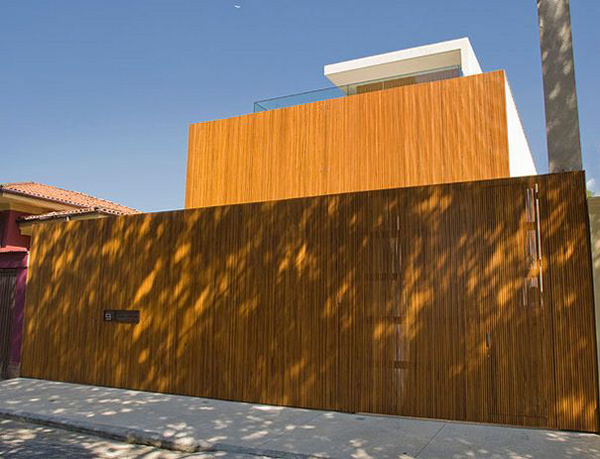
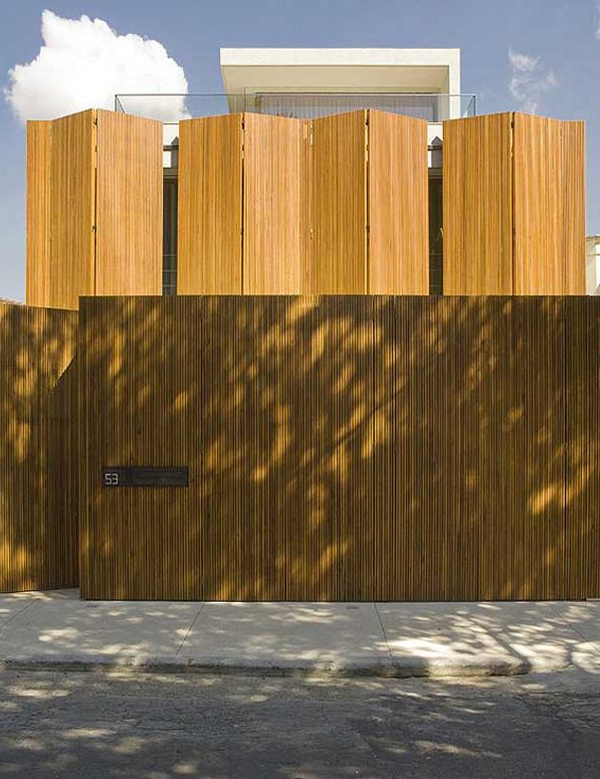
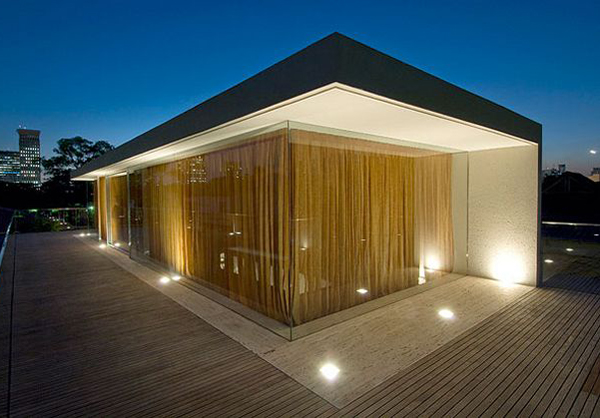
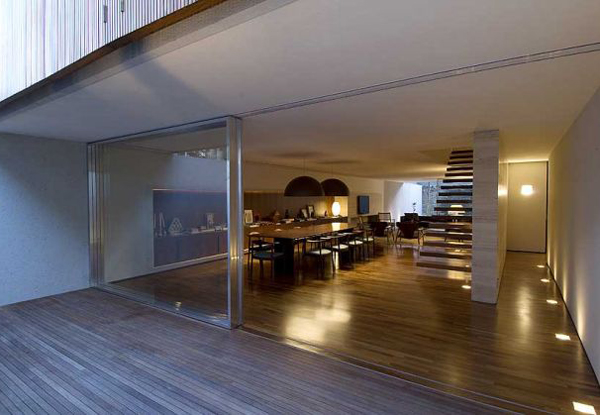




Mark Terra-Salomão | Looking Out Week 6
For Looking Out Week 6, I thought it'd be appropriate to take a look at a project that, much like many of our bath house projects, combines concrete masonry units (CMUs) and wood.
This is a small shed for drying firewood constructed in Paesana, Italy, by StudioErrante Architteture.
The CMU walls were part of a previous shed. They were essentially used as a foundation for the new wooden structure. The outer wood planks are offset so as to let in the air required for drying firewood.
The shed also serves as a workshop and "refuge," and includes a small niche on its street-facing south facade that serves as a seat for people AND animals.
I think ArchDaily provides a better description for this little gem than I ever could: "Details are basic. Definitions are literal. Reinforced concrete is used for base and wall. Wood for almost everything else: laminated wood for structure, burned chestnut for skin and roof, untreated chestnut for frames, plywood for inserts and niche, an old trunk became a step. A poor quality iron frame defines the door. In the end it's only a wall, a box with a niche, a door and its window, two pivots, a step and a handle. Almost nothing else."
For more information: http://www.archdaily.com/390343/wood-and-the-dog-studioerrante-architetture/.
This is a small shed for drying firewood constructed in Paesana, Italy, by StudioErrante Architteture.
The CMU walls were part of a previous shed. They were essentially used as a foundation for the new wooden structure. The outer wood planks are offset so as to let in the air required for drying firewood.
The shed also serves as a workshop and "refuge," and includes a small niche on its street-facing south facade that serves as a seat for people AND animals.
Moral of the story: No matter how hard you try, your first commission will always be a dog house.
I think ArchDaily provides a better description for this little gem than I ever could: "Details are basic. Definitions are literal. Reinforced concrete is used for base and wall. Wood for almost everything else: laminated wood for structure, burned chestnut for skin and roof, untreated chestnut for frames, plywood for inserts and niche, an old trunk became a step. A poor quality iron frame defines the door. In the end it's only a wall, a box with a niche, a door and its window, two pivots, a step and a handle. Almost nothing else."
For more information: http://www.archdaily.com/390343/wood-and-the-dog-studioerrante-architetture/.
Subscribe to:
Posts (Atom)




























